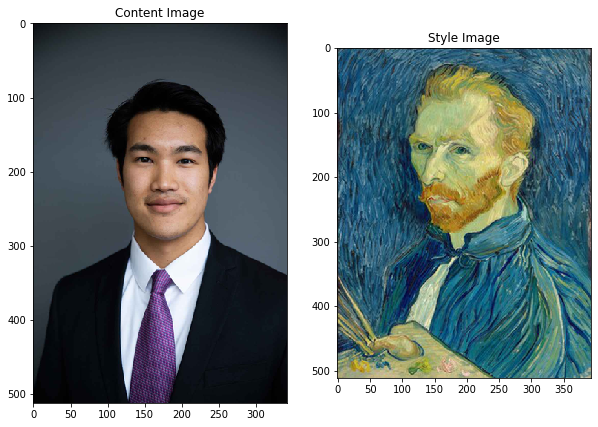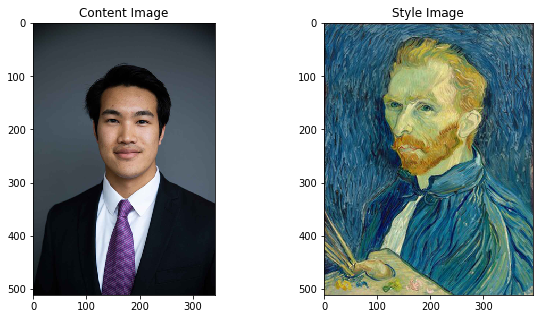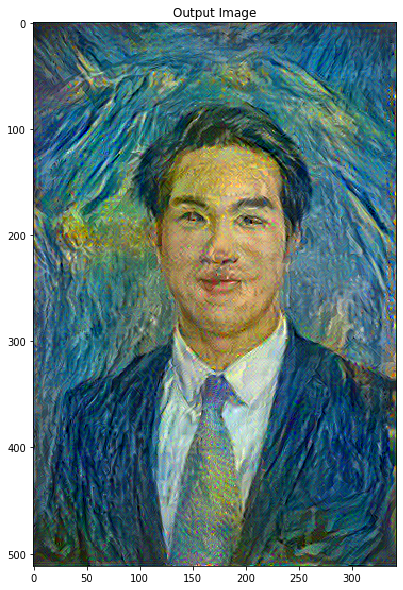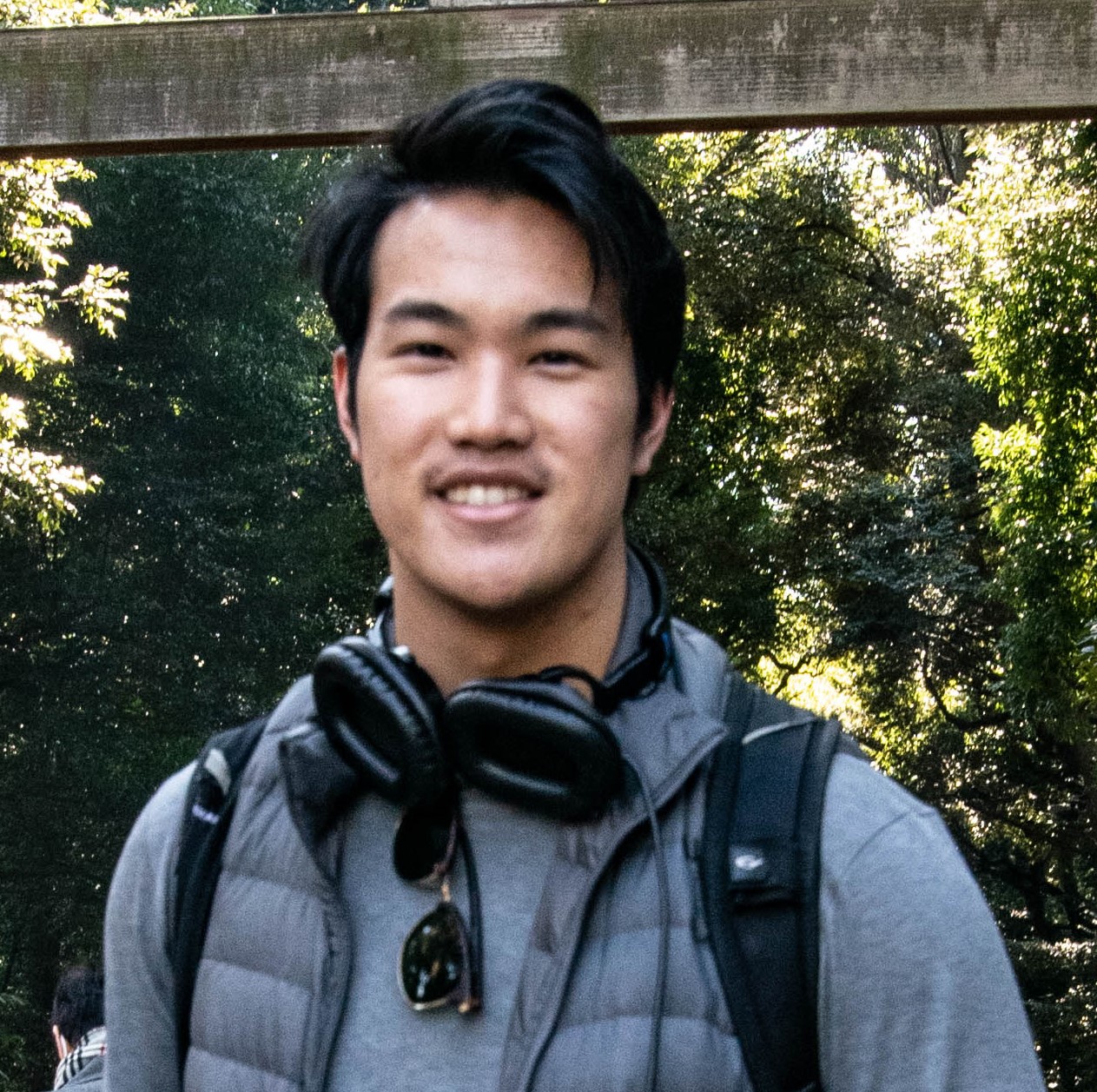Transfer Learning
#Import and configure modules
import matplotlib.pyplot as plt
import matplotlib as mpl
import numpy as np
from PIL import Image
import time
import functools
import tensorflow as tf
from tensorflow.python.keras.preprocessing import image as kp_image
from tensorflow.python.keras import models
from tensorflow.python.keras import losses
from tensorflow.python.keras import layers
from tensorflow.python.keras import backend as K
The default version of TensorFlow in Colab will soon switch to TensorFlow 2.x.
We recommend you upgrade now
or ensure your notebook will continue to use TensorFlow 1.x via the %tensorflow_version 1.x magic:
more info.
mpl.rcParams['figure.figsize'] = (10,10)
mpl.rcParams['axes.grid'] = False
tf.enable_eager_execution()
print("Eager execution: {}".format(tf.executing_eagerly()))
Eager execution: True
# Set up some global values here
content_path = '/content/Victorheadshot.jpg'
style_path = '/content/VanGogh.jpg'
Visualize the input
def load_img(path_to_img):
'''
This function is to load the image
'''
max_dim = 512
img = Image.open(path_to_img)
long = max(img.size)
scale = max_dim/long
img = img.resize((round(img.size[0]*scale), round(img.size[1]*scale)), Image.ANTIALIAS)
img = kp_image.img_to_array(img)
# We need to broadcast the image array such that it has a batch dimension
img = np.expand_dims(img, axis=0)
return img
def imshow(img, title=None):
# Remove the batch dimension
out = np.squeeze(img, axis=0)
# Normalize for display
out = out.astype('uint8')
plt.imshow(out)
if title is not None:
plt.title(title)
plt.imshow(out)
These are input content and style images. We hope to “create” an image with the content of our content image, but with the style of the style image.
plt.figure(figsize=(10,10))
content = load_img(content_path).astype('uint8')
style = load_img(style_path).astype('uint8')
plt.subplot(1, 2, 1)
imshow(content, 'Content Image')
plt.subplot(1, 2, 2)
imshow(style, 'Style Image')
plt.show()

Prepare the data
Create methods that will allow us to load and preprocess our images easily. We perform the same preprocessing process as are expected according to the VGG training process. VGG networks are trained on image with each channel normalized by mean = [103.939, 116.779, 123.68]and with channels BGR.
def load_and_process_img(path_to_img):
img = load_img(path_to_img)
img = tf.keras.applications.vgg19.preprocess_input(img)
return img
In order to view the outputs of our optimization, we are required to perform the inverse preprocessing step. Furthermore, since our optimized image may take its values anywhere between $- \infty$ and $\infty$, we must clip to maintain our values from within the 0-255 range.
def deprocess_img(processed_img):
x = processed_img.copy()
if len(x.shape) == 4:
x = np.squeeze(x, 0)
assert len(x.shape) == 3, ("Input to deprocess image must be an image of "
"dimension [1, height, width, channel] or [height, width, channel]")
if len(x.shape) != 3:
raise ValueError("Invalid input to deprocessing image")
# perform the inverse of the preprocessiing step
x[:, :, 0] += 103.939
x[:, :, 1] += 116.779
x[:, :, 2] += 123.68
x = x[:, :, ::-1]
#clip to maintain our values from within the 0-255 range
x = np.clip(x, 0, 255).astype('uint8')
return x
# Content layer where will pull our feature maps
content_layers = ['block5_conv2']
# Style layer we are interested in
style_layers = ['block1_conv1',
'block2_conv1',
'block3_conv1',
'block4_conv1',
'block5_conv1'
]
num_content_layers = len(content_layers)
num_style_layers = len(style_layers)
def get_model():
"""
Creates our model with access to intermediate layers.
This function will load the VGG19 model and access the intermediate layers.
These layers will then be used to create a new model that will take input image
and return the outputs from these intermediate layers from the VGG model.
Returns:
returns a keras model that takes image inputs and outputs the style and
content intermediate layers.
"""
# Load our model. We load pretrained VGG, trained on imagenet data
vgg = tf.keras.applications.vgg19.VGG19(include_top=False, weights='imagenet')
vgg.trainable = False
# Get output layers corresponding to style and content layers
style_outputs = [vgg.get_layer(name).output for name in style_layers]
content_outputs = [vgg.get_layer(name).output for name in content_layers]
model_outputs = style_outputs + content_outputs
# Build model
return models.Model(vgg.input, model_outputs)
def get_content_loss(base_content, target):
return tf.reduce_mean(tf.square(base_content - target))
def gram_matrix(input_tensor):
# We make the image channels first
channels = int(input_tensor.shape[-1])
a = tf.reshape(input_tensor, [-1, channels])
n = tf.shape(a)[0]
gram = tf.matmul(a, a, transpose_a=True)
return gram / tf.cast(n, tf.float32)
def get_style_loss(base_style, gram_target):
"""Expects two images of dimension h, w, c"""
# height, width, num filters of each layer
# We scale the loss at a given layer by the size of the feature map and the number of filters
height, width, channels = base_style.get_shape().as_list()
gram_style = gram_matrix(base_style)
return tf.reduce_mean(tf.square(gram_style - gram_target))# / (4. * (channels ** 2) * (width * height) ** 2)
def get_feature_representations(model, content_path, style_path):
"""
Helper function to compute our content and style feature representations.
This function will simply load and preprocess both the content and style
images from their path. Then it will feed them through the network to obtain
the outputs of the intermediate layers.
Arguments:
model: The model that we are using.
content_path: The path to the content image.
style_path: The path to the style image
Returns:
returns the style features and the content features.
"""
# Load our images in
content_image = load_and_process_img(content_path)
style_image = load_and_process_img(style_path)
# batch compute content and style features
style_outputs = model(style_image)
content_outputs = model(content_image)
# Get the style and content feature representations from our model
style_features = [style_layer[0] for style_layer in style_outputs[:num_style_layers]]
content_features = [content_layer[0] for content_layer in content_outputs[num_style_layers:]]
return style_features, content_features
def compute_loss(model, loss_weights, init_image, gram_style_features, content_features):
"""
This function will compute the loss total loss.
Arguments:
model: The model that will give us access to the intermediate layers
loss_weights: The weights of each contribution of each loss function.
(style weight, content weight, and total variation weight)
init_image: Our initial base image. This image is what we are updating with
our optimization process. We apply the gradients wrt the loss we are
calculating to this image.
gram_style_features: Precomputed gram matrices corresponding to the
defined style layers of interest.
content_features: Precomputed outputs from defined content layers of
interest.
Returns:
returns the total loss, style loss, content loss, and total variational loss
"""
style_weight, content_weight = loss_weights
# Feed our init image through our model. This will give us the content and
# style representations at our desired layers. Since we're using eager
# our model is callable just like any other function!
model_outputs = model(init_image)
style_output_features = model_outputs[:num_style_layers]
content_output_features = model_outputs[num_style_layers:]
style_score = 0
content_score = 0
# Accumulate style losses from all layers
# Here, we equally weight each contribution of each loss layer
weight_per_style_layer = 1.0 / float(num_style_layers)
for target_style, comb_style in zip(gram_style_features, style_output_features):
style_score += weight_per_style_layer * get_style_loss(comb_style[0], target_style)
# Accumulate content losses from all layers
weight_per_content_layer = 1.0 / float(num_content_layers)
for target_content, comb_content in zip(content_features, content_output_features):
content_score += weight_per_content_layer* get_content_loss(comb_content[0], target_content)
style_score *= style_weight
content_score *= content_weight
# Get total loss
loss = style_score + content_score
return loss, style_score, content_score
def compute_grads(cfg):
with tf.GradientTape() as tape:
all_loss = compute_loss(**cfg)
# Compute gradients wrt input image
total_loss = all_loss[0]
return tape.gradient(total_loss, cfg['init_image']), all_loss
Optimization loop
import IPython.display
def run_style_transfer(content_path,
style_path,
num_iterations=1000,
content_weight=1e3,
style_weight=1e-2):
# We don't need to (or want to) train any layers of our model, so we set their
# trainable to false.
model = get_model()
for layer in model.layers:
layer.trainable = False
# Get the style and content feature representations (from our specified intermediate layers)
style_features, content_features = get_feature_representations(model, content_path, style_path)
gram_style_features = [gram_matrix(style_feature) for style_feature in style_features]
# Set initial image
init_image = load_and_process_img(content_path)
init_image = tf.Variable(init_image, dtype=tf.float32)
# Create our optimizer
opt = tf.train.AdamOptimizer(learning_rate=5, beta1=0.99, epsilon=1e-1)
# For displaying intermediate images
iter_count = 1
# Store our best result
best_loss, best_img = float('inf'), None
# Create a nice config
loss_weights = (style_weight, content_weight)
cfg = {
'model': model,
'loss_weights': loss_weights,
'init_image': init_image,
'gram_style_features': gram_style_features,
'content_features': content_features
}
# For displaying
num_rows = 2
num_cols = 5
display_interval = num_iterations/(num_rows*num_cols)
start_time = time.time()
global_start = time.time()
norm_means = np.array([103.939, 116.779, 123.68])
min_vals = -norm_means
max_vals = 255 - norm_means
imgs = []
for i in range(num_iterations):
grads, all_loss = compute_grads(cfg)
loss, style_score, content_score = all_loss
opt.apply_gradients([(grads, init_image)])
clipped = tf.clip_by_value(init_image, min_vals, max_vals)
init_image.assign(clipped)
end_time = time.time()
if loss < best_loss:
# Update best loss and best image from total loss.
best_loss = loss
best_img = deprocess_img(init_image.numpy())
if i % display_interval== 0:
start_time = time.time()
# Use the .numpy() method to get the concrete numpy array
plot_img = init_image.numpy()
plot_img = deprocess_img(plot_img)
imgs.append(plot_img)
IPython.display.clear_output(wait=True)
IPython.display.display_png(Image.fromarray(plot_img))
print('Iteration: {}'.format(i))
print('Total loss: {:.4e}, '
'style loss: {:.4e}, '
'content loss: {:.4e}, '
'time: {:.4f}s'.format(loss, style_score, content_score, time.time() - start_time))
print('Total time: {:.4f}s'.format(time.time() - global_start))
IPython.display.clear_output(wait=True)
plt.figure(figsize=(14,4))
for i,img in enumerate(imgs):
plt.subplot(num_rows,num_cols,i+1)
plt.imshow(img)
plt.xticks([])
plt.yticks([])
return best_img, best_loss
best, best_loss = run_style_transfer(content_path,
style_path, num_iterations=4000)

result = Image.fromarray(best)
result.save('out.jpg')
def show_results(best_img, content_path, style_path, show_large_final=True):
plt.figure(figsize=(10, 5))
content = load_img(content_path)
style = load_img(style_path)
plt.subplot(1, 2, 1)
imshow(content, 'Content Image')
plt.subplot(1, 2, 2)
imshow(style, 'Style Image')
if show_large_final:
plt.figure(figsize=(10, 10))
plt.imshow(best_img)
plt.title('Output Image')
plt.show()
WARNING: Creepy eyes past this point!
show_results(best, content_path, style_path)


One of the impressive things to me is seeing paint brush strokes. Also, it seemed to have a hard time handling the patterned tie.
